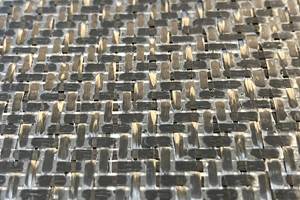DLR researchers develop new repair concept for FRPs
The process uses a laser, induction and a vacuum on damaged areas.
Researchers at the German Aerospace Center (DLR, Stuttgart, Germany) have developed a new repair concept for fiber-reinforced polymers (FRPs) with the aim to avoid the premature disposal of FRP components and to minimize waste during production.
Since the production of FRP components is complex and costly, the repair processes is generally time-intensive and expensive. Large structures – such as those in an aircraft fuselage – are designed for a service life of up to 30 years. “In the event of damage, they usually have to be removed for repair or completely replaced," said Project Leader Markus Kaden from DLR.
With metal structures, the damaged area is cut out and new metal riveted in. Components made of fiber-reinforced polymers require a more complex repair process. "As the fibers are load-bearing and are responsible for the cohesion and resilience of the structure, we cannot simply drill and rivet here; that would only damage the fibers even more," says Kaden. Instead, the DLR scientists remove the damaged layers of the material and replace them with a patch similar to a sticking plaster. The patch is made of the same material, has the same fiber alignment and is bonded to the surrounding structure using the effects of heat and pressure.
The repair process used by DLR here has two special features. First, the damaged material is removed using a laser. This process does not require any cooling; there are no clamping or pressure forces on the structure and the tool wear is very limited.
Second, the researchers only heat the area of the patch and the damaged area of the structure. They do so using a metal sheet heated by induction that is the same size as the patch and is pressed onto the patch by creating a vacuum. The patch is then bonded with the surrounding structure under pressure and at a high temperature, Kaden said.
The researchers believe the new repair method offers more flexibility than previous technologies. By using ovens or autoclaves, the entire component is heated. Heating blankets, infrared lights or heated air systems offer the possibility of heating only parts of the structure, but are not specifically targeted to the specific area to be repaired. At the same time, DLR uses an additional insulation layer to achieve temperatures of over 300 degrees Celsius so that even thermoplastics can be repaired.
Working with the DLR technology marketing team, the researchers in Stuttgart have developed a mobile repair station that can be used to demonstrate the process. It includes all the systems required for repairing FRP structures. In addition to the equipment for inductive heating of the metal sheet, it has a vacuum pump for generating the required pressure on the patch. The individual processes can be controlled via a netbook using temperature sensors.
Currently, 'bonding' is not yet approved in the aviation sector for repairing load-bearing structural components made of high-performance composites. However, Kaden is optimistic. "There are currently many new developments in this area. Several companies have already shown interest in our repair concept and in developing it further for industrial use," he said.
Related Content
IPSA acquires bonding adhesives based on MMA technology
IPS Adhesives (IPSA) introduces a line of adhesives using acrylate and MMA technology from L&L Products for the bonding of dissimilar materials such as metals and composites.
Read MoreBiDebA project supports bio-based adhesives development for composites
Five European project partners are to engineer novel bio-based adhesives, derived from renewable resources, to facilitate composites debonding, circularity in transportation markets.
Read MoreResins, additives, adhesives and 3D printing solutions
CAMX 2023: Arkema’s broad portfolio of products for composites fabricators aim to enhance performance, durability and sustainability.
Read MorePontacol thermoplastic adhesive films are well-suited for composite preforms
Copolyester- and copolyamide-based adhesive films eliminate the need for sewing threads or binders when stacking laminates while improving the final part’s mechanical properties.
Read MoreRead Next
Plant tour: Daher Shap’in TechCenter and composites production plant, Saint-Aignan-de-Grandlieu, France
Co-located R&D and production advance OOA thermosets, thermoplastics, welding, recycling and digital technologies for faster processing and certification of lighter, more sustainable composites.
Read More“Structured air” TPS safeguards composite structures
Powered by an 85% air/15% pure polyimide aerogel, Blueshift’s novel material system protects structures during transient thermal events from -200°C to beyond 2400°C for rockets, battery boxes and more.
Read MoreDeveloping bonded composite repair for ships, offshore units
Bureau Veritas and industry partners issue guidelines and pave the way for certification via StrengthBond Offshore project.
Read More


























